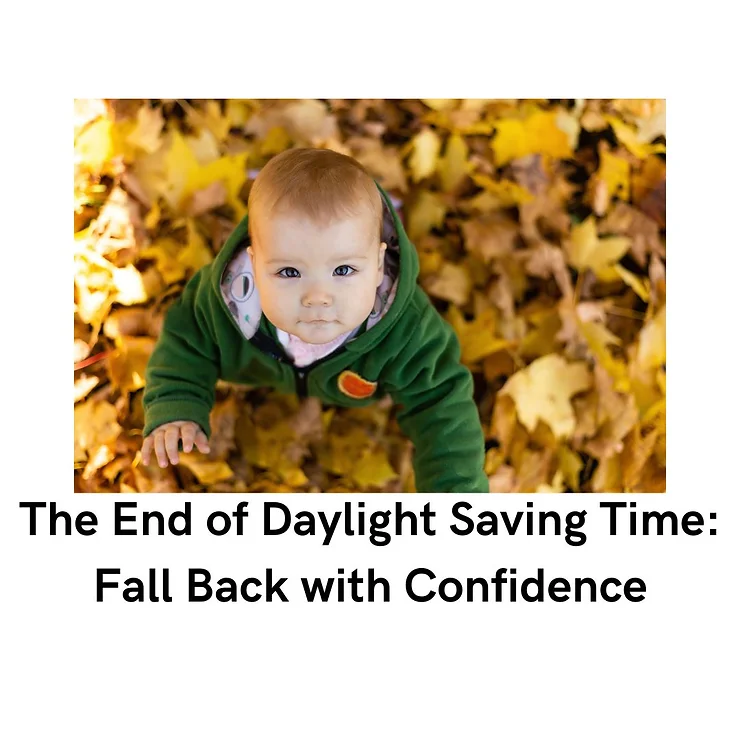Daylight Saving Time is ending soon on Sunday, November 3 2024 at 2am.
It means more sun in the morning, and more darkness in the evening.
It means that suddenly, on Sunday morning, the clock will read one hour earlier than usual.
It might feel like 7am when your children wake up, but really they have started their day at 6am. Basically, we get a whole extra hour added to our days!
There are a few ways to best prepare for this annual change depending on the sensitivity of your little sleeper. If you have a more sensitive sleeper who struggles when naps are missed or schedules are shifted, then a gradual approach may be appropriate, and you can offer this gradual approach either before or after the time change. If you have a less sensitive sleeper, then you can get away with a less gradual approach. Read more below about how to best facilitate a smooth transition based on the sensitivity or adaptability of your child.
For the Parents of Sensitive Sleepers:
1. Preparing in Advance of the Change:
Set a reminder for October 27 to gradually shift bedtime later by 15 minute increments every two days. By the time November 3 rolls around, your child will be ready for a bedtime that is one hour later than usual. Just make sure to also gradually shift your child’s OK to Wake time and nap times by the same 15 minute increments so everything lines up smoothly.
2. Adjusting After the Change:
Shift bedtime earlier (based on the new clock time) by 45 minutes on November 3 and 4, followed by 30 minutes earlier on November 5 and 6, only 15 minutes earlier on November 7 and 8, and then you are back in sync with the new clock time by November 9.
For the Parents of More Flexible Sleepers:
Adjust right along with the clock! No need to plan ahead and recognize that if your child does demonstrate minor sleep disruptions, they will subside soon as long as lovingly firm boundaries around sleep are maintained.
It is worth noting though, that too late bedtimes can make sleep more difficult for babies and young children, so even if your child tends be adjust to changes easily, it may help to offer a few nights of extra early bedtimes (15-30 minutes earlier than normal) to help them avoid going to bed in an overtired state that will make sleep more difficult. This is my go-to recommendation for most families I work with and how I support my own children during time changes.
Regardless of the exact approach you use to help your child adjust to the time change, I have THREE recommendations to make the process easier on your little one.
Top 3 Time Change Tips!
ONE: Get Outside!
Circadian rhythms need to adjust, and exposure to direct sunlight is going to be the most efficient and direct way to assist in this transition. Get your little one outside as much as possible during wake times to help their little brains recognize the clear difference between the light that is present during daytime play and the absence of light that is present during sleep times.
TWO: Ensure the Sleep Environment is Conducive to Sleep.
This means the room is safe, boring, cool, quiet, and dark. Is there light coming into your child’s sleep room? Block it and then bask in the joy when you see how much easier they are going to fall asleep and stay asleep in a truly blacked out room.
THREE: Keep Routines Around Sleep Consistent.
Your lovingly simple but extremely predictable bedtime and pre-nap routines should be a constant no matter when exactly sleep times land. These routines keep our kiddos feeling safe and secure, and ease transitions from wake to sleep even amidst big changes.
If you can do those three things to facilitate a smooth time change around your child’s sleep needs, then you are in a good place already and you have very lucky kids.
If sleep for your child is often a challenge, read more about my Top 5 Healthy Sleep Tips for babies, toddlers, and preschoolers.
If you’re looking for more information on biological appropriate sleep times, check out these blog posts about ideal sleep schedules based on age
Lastly, if you’re interested in working one on one with a comprehensive and fully personalized sleep plan to meet the needs of your family and unique child, schedule a free 15 Minute Discovery Call.

